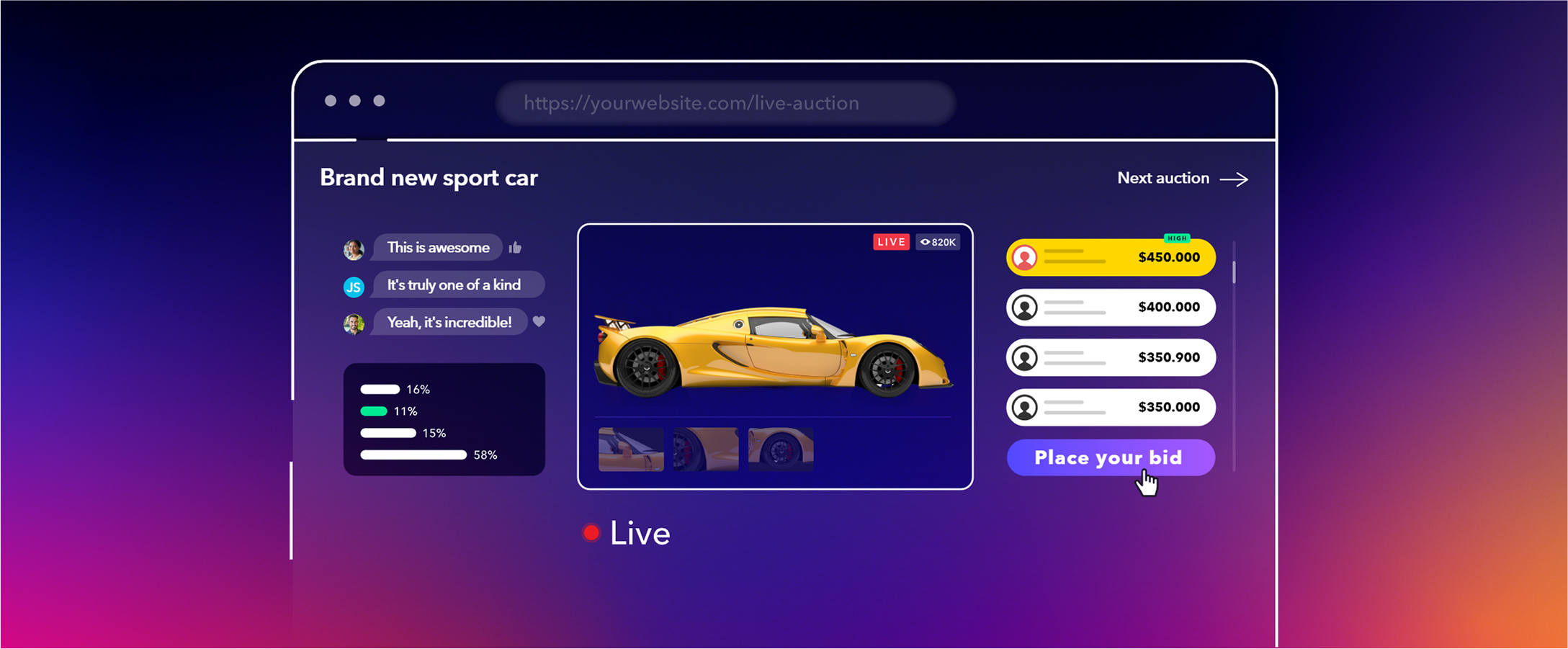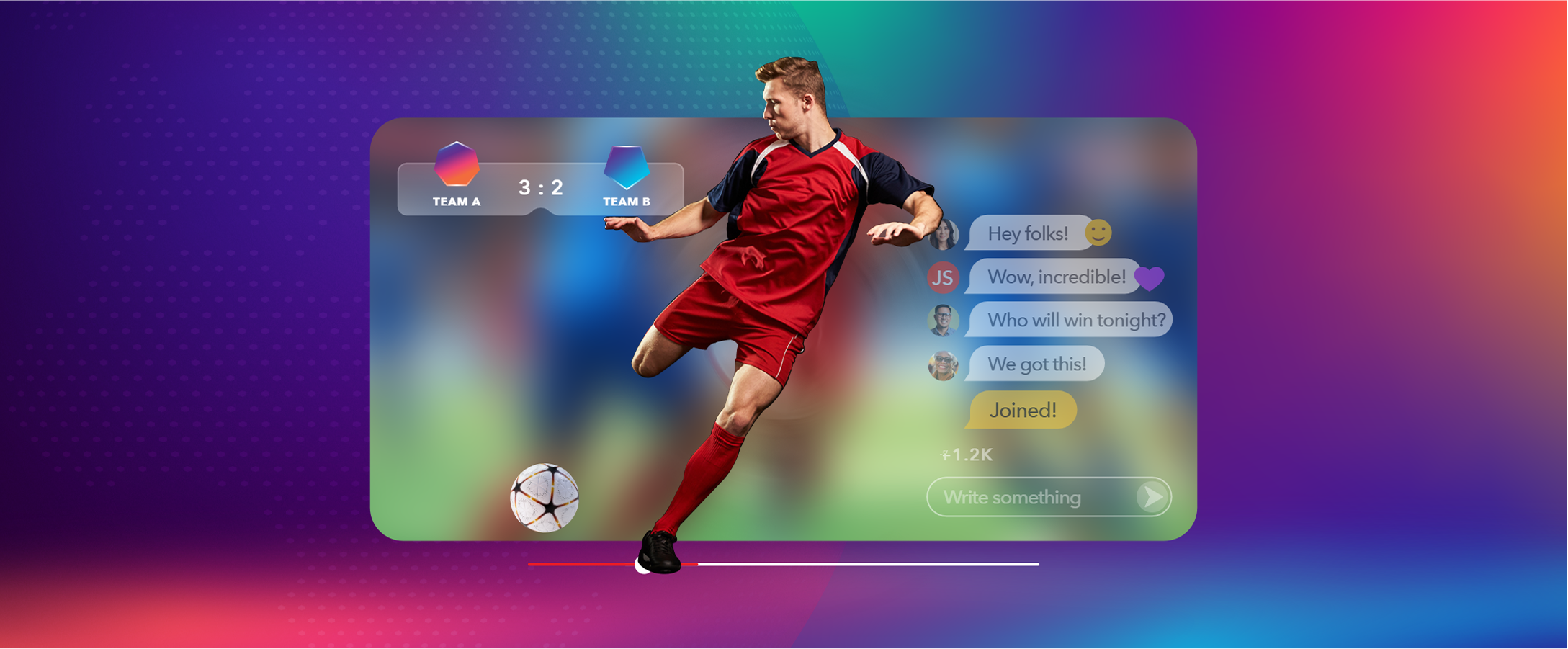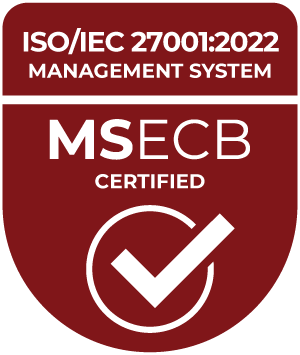Online auctions have been around for almost the entirety of the internet’s lifespan. However, as video streaming technology advances, live online auctions are gaining popularity.
This innovative e-commerce model leverages ultra-low latency live streaming to offer real-time interaction between bidders and auctioneers.
This article will discuss the ins and outs of creating an online auction website with real-time streaming. We’ll review some benefits and walk you through the step-by-step process for creating a live auction website. Let’s start by discussing how live auctions differ from timed auctions.
Live auctions vs. timed auctions: what’s the difference
There are two types of online auctions you can host on your site: live auctions and timed auctions. The primary difference between these two types of auctions lies in their formatting.
Live auctions mimic in-person auctions, where items are presented by a live auctioneer over a real-time video stream. Bidding occurs in real-time, making it a fast-paced process. The fast-paced nature of live auctions puts more pressure on bidders, which can lead to higher bids.
Timed auctions are closer to a traditional e-commerce experience where items have their own landing pages. However, interested buyers can place a bid instead of the typical “add to cart” checkout flow. Timed auctions are easier to manage but don’t create the same pressure to buy as a live auction.
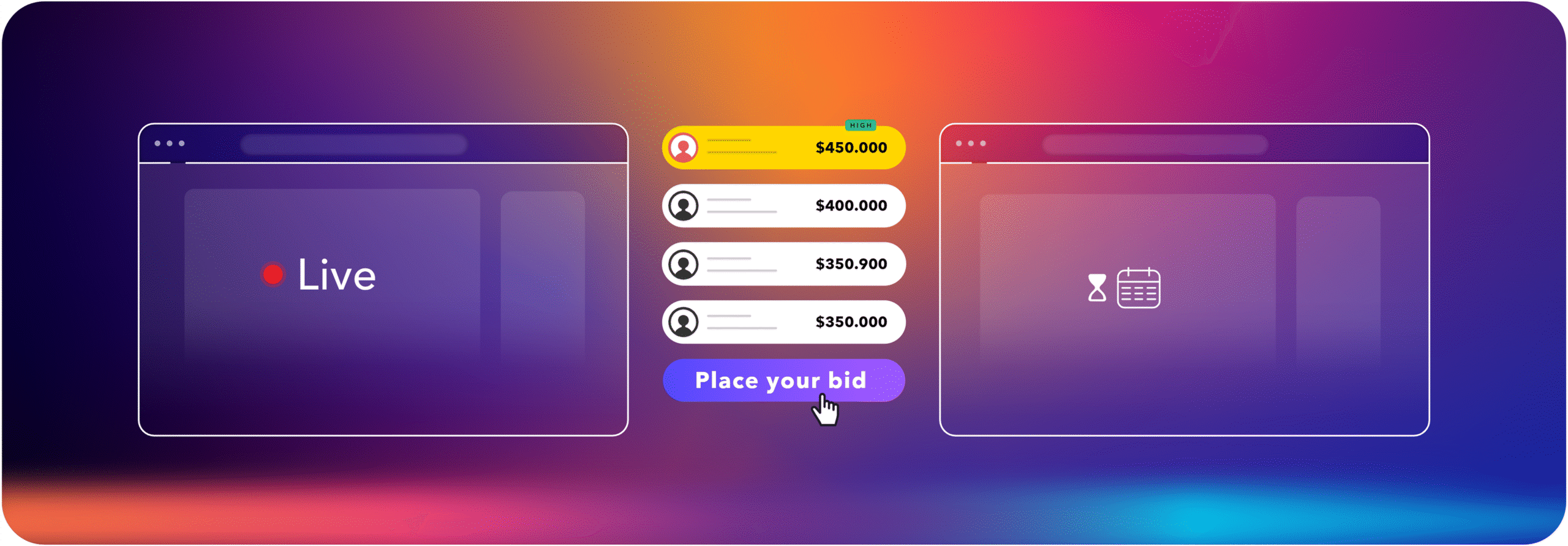
Why build an auction website?
Auction websites are appealing business ventures for entrepreneurs because they create high-pressure scenarios that encourage people to make purchases.
Auctioning is particularly useful for entrepreneurs who want to sell unique or limited-edition items, and hosting an auction online opens doors to a much broader buyer base. A couple of the most common items sold at online auctions include luxury goods, collectibles, farm equipment, and livestock.
Auction websites can also be a more profitable alternative to in-person auctions since they don’t require much physical space. When your auction happens online, there’s no need to pay for a venue for bidders to gather. With lower expenses, there’s plenty of room for your bottom line to improve.
What to look for in a streaming solution for live auctions
A live auction website requires the support of a streaming platform that includes real-time streaming. This technology features a video player that can be embedded within your website, making your live auction streams accessible to your viewers.
As you seek a streaming solution to support your auction website development process, there are several critical features and functions to consider. Let’s check them out.
Real-time streaming
Real-time video streaming is an absolute must for creating a live auction website. You’ll need a solution that utilizes cutting-edge protocols, such as WebRTC and HESP, to deliver streams with sub-500ms latency.
Real-time latency is significant because of the interactive nature of online auctions. It allows bids to be placed and called in real-time, giving every prospective buyer an equal opportunity to bid. Plus, it enhances the interactivity of your streams and enables you to improve your bidder engagement.
Keep in mind that if you can create an auction site without live streaming, you’d be limited to selling items with timed auctions.
Bidding technology
Technology enabling users to bid on the items they want to purchase is a must. Your chosen streaming solution must either be equipped with bidding technology or easily integrated into a bidding system.
Of course, you can have technology that is separate from the video component of your website, but this can compromise the user’s experience. A fully integrated workflow tool will provide the most optimal user experience.
This technology should be integrated with the tools you use to manage your order fulfilment workflow. It should also be equipped with secure transaction technology to protect both you and your buyers. For many use cases, an auction tool that enables you to add both timed and live auctions to your website can be very helpful.
High-quality content
Since live auctions are a form of live commerce, providing a high-quality viewing experience is crucial. The video and audio must both be consistently clear so you can best showcase the items you’re selling.
It’s also essential to opt for a solution with an infrastructure for global scalability. This way, you can ensure that the quality of your stream stays consistent for viewers both near and far.
Flexible viewing layouts
When buyers bid on high-ticket items, such as classic vehicles or agricultural equipment, they want to see the goods from every angle possible. That’s where flexible viewing layouts come into play.
With tools like multiview from Dolby OptiView, you can feature streams from multiple camera angles to create a more immersive experience for bidders. This gives viewers a better look at the items available, just like they’d have if they were checking out a product in person.
[insert a product photo here]
Mobile optimization
To make your live streams accessible to more users and broaden your target audience, ensure your site is optimized for mobile streaming. You’ll need the support of a solution that facilitates cross-platform streaming.
App development can also be helpful depending on the scale of your operation. You can start with a mobile-friendly website and add an app experience as your operation grows.
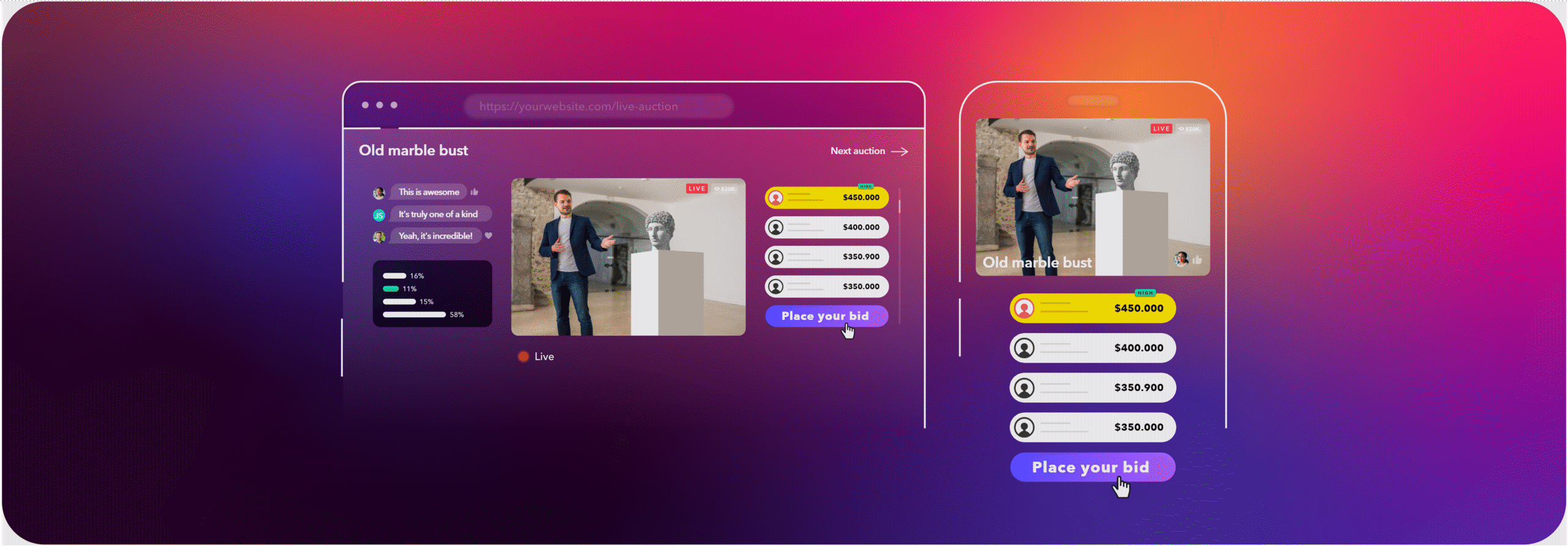
How to create an auction website in 8 steps
Creating a profitable auction website is straightforward with proper planning and the support of the right tools. You can bring your auction site to life in eight steps.
1. Create a plan
The first step to building an auction site is to make a plan. This step may seem basic, but it is crucial because it will guide you through the auction website development process.
The first thing to figure out is your niche. Most auction niches are related to items available in minimal quantities, such as curated collections of antiques or artwork. Some online auctioneers have slightly more general niches, like estate sales, overstock sales, or unclaimed property sales.
From there, you’ll want to determine your general auction frequency. You don’t need to get super granular yet, but a rough idea of how often you’ll stream will help your decision-making throughout the development process.
Other important considerations include your fulfillment process, your ideal customer, the regions you’ll sell in, service fees, commission breakdowns, and so forth.
2. Handle the legalities
Another vital step to building your auction website is to handle the legalities, such as registering your business and ensuring your entity is configured in a way that makes the most sense for tax purposes. If you already have an auction business, this step involves ensuring you’re set up to operate an online element of your business.
You should look into the local guidelines for auctions and auctioneers at this stage. Depending on your location, different certifications and licensing are typically required. Hiring a business lawyer with experience in auction regulations can help ensure compliance.
3. Source your items
The next step is to source your items. Again, if you already have an established auction business, you have this down pat. However, if you’re starting a new auction business, you must determine where you’ll get the items you sell.
How this looks depends entirely on the niche you’ve chosen. If you offer auction services for estate sales, you’ll need to find clients with homes they want to clear. If you own an art collective or manage artists, selling work from your group is a no-brainer.
4. Choose a streaming solution
You’ll need a streaming solution to bring your auctions to life. This technology integrates into your chosen website builder.
Earlier in this guide, we discussed some non-negotiables to look for in this platform, but it’s up to you to determine which specific features you need to reach your goals. For example, if you want a live chat feed for bidders, you must choose a platform that integrates with community tools.
If you’re looking for an end-to-end streaming platform that offers real-time streaming, Dolby OptiView could be the solution for you. Contact us to learn how our technology can fit into your live auction streaming workflow.
5. Design the experience
Now, it’s time to design the casino website. Start by mapping out the user experience (UX). Hiring a professional designer with e-commerce experience is a must.
As you design your website’s UX, the bidding process should be your top priority. Ensuring this process is smooth will help reduce any friction in the purchase. You must look at the web hosting solutions and compatible integrations available to provide this experience.
If your vision includes a mobile app as part of your experience, you’ll need to decide whether it will be part of the initial offer or if you’ll simply optimize your website for mobile use. Making an app part of a secondary release is an excellent approach if you’re working on a tight budget or trying to expedite your time to market.
6. Develop your site
Once your design has been finalized, your site will move on to development. Smaller operations typically outsource this work to an agency or freelancers, but larger companies could hire an in-house team. Having at least one person in-house who is familiar with web development helps maintain and update the site.
If you plan to launch with a mobile app, you’ll also need developers specializing in mobile development. Since investing in this specialized support is costly, you may consider launching your app after your business is up and running.
7. List your items
Once your site is developed, it’s time to list the items you’re auctioning off. Even if you’re using a live auction format, creating unique listings for each product will help keep everything more organized.
It’s beneficial to produce individual product pages to ensure prospective bidders can access all of the vital information about each item. This includes product images, specs, shipping information, and so forth.
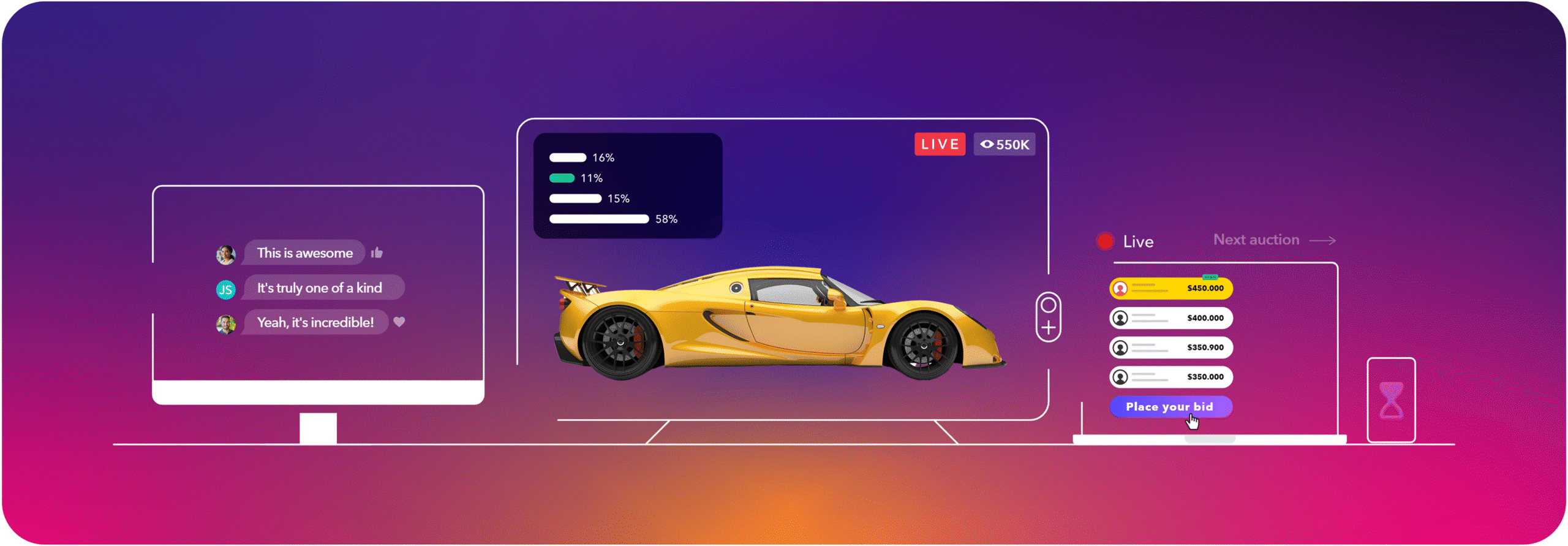
8. Test and launch
The last step before launch is testing your user experience (UX) to ensure everything flows as intended. Test your auction website on multiple devices and browsers to ensure the experience is optimized for as many scenarios as possible.
It’s time to launch once you’ve confirmed everything is working as intended. How you structure your launch depends on your intended streaming schedule. For example, if you’re hosting a monthly auction, you’ll market that event differently from hosting multiple auctions per day.
Two approaches you could take include marketing the auction or the items you’re selling. Even if you put most of your resources into marketing the event, running ads for the top products you’re selling is probably worth it. You should also tap into other digital marketing techniques, like social media marketing, email marketing, and SEO.
Final thoughts
A live auction website can be a lucrative business venture when done right. With the right streaming solution, it is possible to create online experiences that mimic in-person auctions.
Ready to leverage real-time streaming to bring your live auctions to life? Contact us to learn how our end-to-end streaming solution can support you through your auction site build.
FAQs
Building an auction website involves many variables, so the cost can vary greatly. A simple site can be built for a couple of thousand dollars, but more complex sites with a companion app can cost upwards of $100,000.
Real-time video streaming enables auctioneers to present products and announce bids as they are received, just as they would in a real-life auction. The only significant difference is that buyers in an online auction can bid from anywhere, not just the physical location where the items are being auctioned off.
You will need a live streaming solution equipped with innovative auction tools in order to build a live auction website. Some of the most critical features to look for as you shop for a solution include:
- Consistently high-quality video delivery for optimal viewer experiences
- Robust infrastructure for global scalability
- Sub-500ms latency to streamlines interactivity
- Production tools for live clipping, multicasting (re-streaming), post-recording audits, and more
Dolby OptiView offers support for all of these crucial tools and more. Learn more about how our live auction streaming solution can help you bring your auction website to life.



